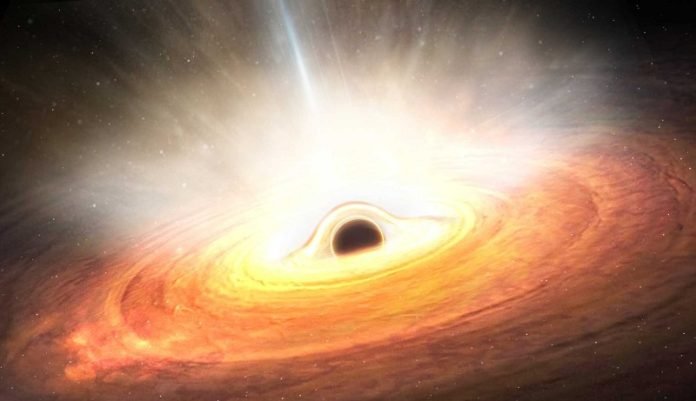
Imagine a toddler tossing their dinner everywhere, and you’ve got a pretty good picture of how black holes behave in space.
Scientists have recently caught a black hole in the act of making a huge mess, using powerful telescopes to watch it throw its ‘food’ around.
This discovery helps us understand why some galaxies, like our own Milky Way, don’t seem to make new stars in certain areas.
The findings were shared in The Astrophysical Journal Letters, shedding light on the complex dance between black holes and the galaxies they reside in.
At the center of large galaxies, there’s a supermassive black hole, a cosmic vacuum cleaner with a gravitational pull so strong it sucks in gas from its surroundings.
This gas doesn’t go straight into the black hole’s ‘mouth’; instead, it swirls around in a glowing disk. Imagine water going down a drain, lighting up as it gets closer to the center. Most of this gas eventually gets eaten by the black hole, but not all of it.
Some of the gas manages to escape, flung out into space like the way a messy eater scatters crumbs.
But every now and then, a black hole doesn’t just drop a few crumbs; it flips the whole table over.
This dramatic tantrum sends gas flying in every direction, clearing out the area around the black hole and stopping new stars from forming.
Researchers from the University of Michigan used the European Space Agency’s X-ray telescope, XMM-Newton, to observe one such cosmic tantrum.
They were studying a galaxy called Markarian 817, which suddenly went quiet, puzzling the scientists. It was like a noisy room suddenly falling silent.
They discovered that the black hole was blowing ultra-fast winds across the galaxy, acting like a giant leaf blower clearing out the space around it.
These winds were so powerful and fast, they blocked out the X-rays usually seen coming from the galaxy’s center. It’s as if the black hole was putting up a shield, hiding its messy eating habits from the universe.
This wasn’t just a one-off event. The black hole in Markarian 817 was caught producing a storm of wind that lasted for hundreds of days, with different ‘gusts’ moving at incredible speeds.
This discovery is a big deal because it helps solve a mystery: why do some galaxies have large empty areas where no new stars are forming? It turns out black hole winds could be the cosmic gardeners, trimming away the raw materials needed to make new stars.
The team used multiple telescopes to catch this black hole in the act, including NASA’s Swift and NuSTAR telescopes. Their work shows just how important it is to keep an eye on the universe for long periods. Sometimes, you need to watch and wait to see the universe’s secrets revealed.
This research isn’t just about understanding one messy black hole; it’s about seeing the bigger picture of how galaxies evolve over time. Black holes might seem like cosmic troublemakers, but their messy eating habits and the winds they produce play a crucial role in shaping their galactic homes.
By studying these cosmic phenomena, scientists are unraveling the mysteries of the universe, one black hole tantrum at a time.



